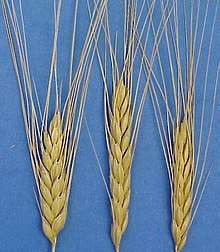Farro
Farro is a food composed of the grains of certain wheat species, sold dried, and prepared by cooking in water until soft. It is eaten plain or is often used as an ingredient in salads, soups, and other dishes.


Definition
Farro is an ethnobotanical term for three species of hulled wheat: spelt (Triticum spelta), emmer (Triticum dicoccum), and einkorn (Triticum monococcum). Hulled wheat is wheat that cannot be threshed.[1] In Italian cuisine, the three species are sometimes distinguished as farro grande, farro medio, and farro piccolo.[2] In French the three species are sometimes distinguished as grand épeautre, moyen épeautre and petit épeautre — épeautre being French for spelt.
Emmer is by far the most common variety of farro grown in Italy, specifically in certain mountain regions of Tuscany and Abruzzo. It is also considered higher quality for cooking than the other two grains and thus is sometimes called "true" farro.[3] Spelt is much more commonly grown in Germany, Austria and Switzerland.
Confusion about the terminology for these three wheat varieties is generated by the difficult history in the taxonomy of wheat and by colloquial and regional uses of the term farro. For example, emmer grown in the Garfagnana region of Tuscany will be colloquially simply known as farro.[2] Also, some English speakers assume farro refers to steamed or boiled grain presented as salad and similar dishes rather than to the three grains themselves. Farro is also sometimes referred to inaccurately as "spelt" in English, neglecting the fact that the term refers to all three grains – emmer, einkorn and spelt.[4][5]
Etymology
The Italian word farro derives from the presumed Latin word farrum, from Standard Latin far, farris n. : a kind of wheat (as in farina (food)). Far, in turn, derives from the Indo-European root *bʰar-es- : (spelt), which also gave rise to the English word barley, Albanian bar : grass, Old Church Slavonic брашьно (brašĭno) : flour, and Greek Φήρον (phḗron): plant deity.
See also
References
- Szabó, A. T., and K. Hammer. "Notes on the Taxonomy of Farro: Triticum monococcum, T. dicoccum, and T. spelta". Padulosi, S., K. Hammer and J. Heller, eds. 1996. Hulled Wheats. Promoting the conservation and use of underutilized and neglected crops. 4. Proceedings of the First International Workshop on Hulled Wheats, 21-22 July 1995, Castelvecchio Pascoli, Tuscany, Italy. International Plant Genetic Resources Institute, Rome. 2-3. Print.
- Markus Buerli (2006). "Farro in Italy" (PDF). The Global Facilitation Unit for Underutilized Species. Retrieved December 23, 2017 – via Bioversity International.
- Hamlin, Suzanne (June 11, 1997). "Farro, Italy's Rustic Staple: The Little Grain That Could". New York Times. Retrieved November 22, 2012.
- Schlegel, Rolf H. J. (2010). "Farro". Dictionary of Plant Breeding (2nd ed.). Boca Raton: CRC. p. 149. Print.
- Julavits, Heidi (November 30, 2008). "Grain Exchange". The New York Times.